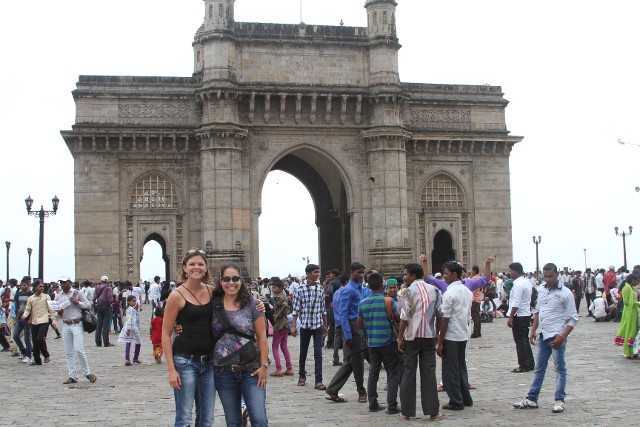The good people of Virgin Atlantic flew us from London to Asia, our fourth continent, for a week in India. We landed in Mumbai, the entrepreneurial and Bollywood capital of India. We were lucky to have amazing friends, Kiran and Riyaaz, who generously made sure our experience was 5 star. I cannot imagine what it would be like to navigate this city without resourceful guides who serve as guardian angels.
Mumbai is chaotic. Black taxis with Ganesha statues compete with rickshaws, three wheeled contraptions without doors that zoom in and around traffic. Everyone honks to compete for slivers of space, and traffic lanes do not exist, which makes L.A. or New York traffic seem civilized and genteel in comparison. Red lights are ignored, and I felt as near death as I ever have when a taxi drove us to the airport.
Mumbai is a city of extremes. Extreme poverty and wealth are situated adjacent to one another. A picturesque coastline is littered with trash and young children and mothers who wash the family’s linens and clothes in dirty, greyish seawater. Ugly building facades contain clean, tastefully decorated modern flats. Tall high-rise financial buildings and luxury apartments compose a breathtaking skyline, but upon closer examination you can see that some of the buildings are unfinished and forgotten. Throughout even the city’s most upscale neighborhoods, rows of families live in small square structures made of scrap metal, cardboard and wood. Without running water, someone must rise early in the morning and walk with buckets to fetch water from community taps. Perhaps the most glaring extreme is in the bustling entrepreneurial spirit of Mumbai where we met models, DJs, musicians, fashion designers and savvy clothing distributors. However, India adheres to an implicit caste system, and those born to families living in poverty become the domestic staff of those born to families of lighter skin and privilege.
Our experience was also one of extremes. At the positive end, Kiran and Riyaaz treated us to every comfort imaginable. It was the first time I’d ever lived like royalty. Gunshum, their “houseboy” made us three delicious meals a day. We ate dosha, curries, and daal, always served with freshly made naan. They arranged for us to have drivers and organized an amazing, romantic dinner at The Tasting Room, one of Riyaaz’s finest restaurants. We enjoyed top-notch service, wine, cheese, prawns, tenderloin and dessert. We also savored culinary delights at his Smokehouse Grill restaurants, which made our frequent European diet of ham and cheese sandwiches a distant memory.
At the other extreme, the culture shock of monsoon season, Mumbai’s fast paced demeanor, and the nakedness of poverty were difficult to process. Locals reassured us that Mumbai was safe to walk in, and we did not feel overtly threatened. However, heavy traffic and curvy streets without names or sidewalks meant navigating on foot was next to impossible, which made us feel a bit trapped at times.
Mumbai is unique, and the interviews in India were as diverse as any place we have been. We captured the stories of 2 women and 4 men ages 25-58, high school to Oxford educated, housewife to successful businessman. The parallels to Western culture were undeniable, yet modern attitudes about gender, politics, and business were interwoven with the country’s more conservative religious and colonial history. It was a week we will always remember and a reminder of why we are doing this type of research. We believe it is next to impossible for the field of Positive Psychology to accurately interpret data about love, passion and peak experience without developing an awareness of the memes prevalent in the research context. Although we visited only one city in India, our awareness of the culture will allow us to ask interesting questions and see patterns that beforehand may have been hidden or obscured by our assumptions.




